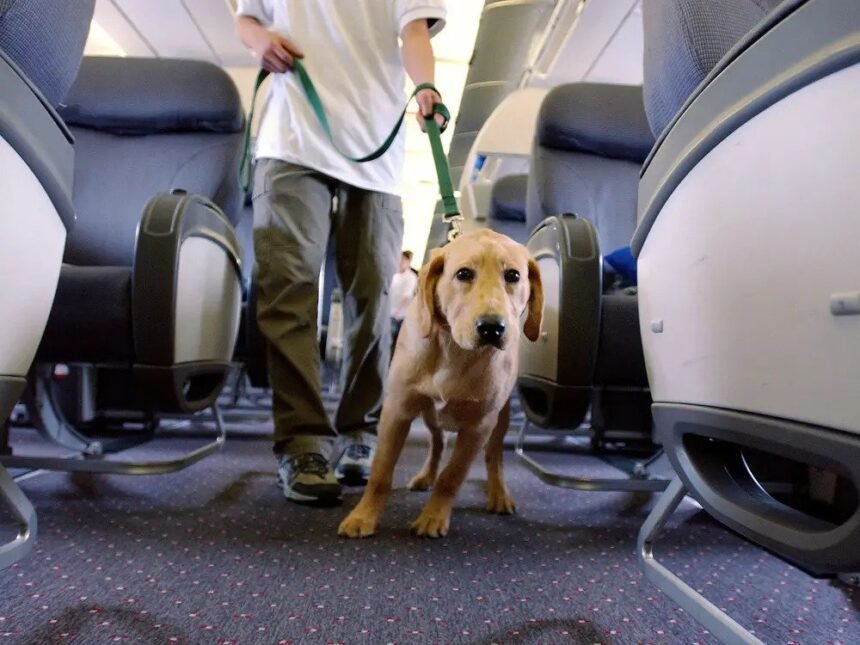Traveling by air with your dog can be a rewarding experience. Still, it requires careful preparation to ensure a safe and comfortable journey for you and your furry friend. Airlines have specific regulations and guidelines for pet travel, and adhering to these protocols is essential to avoid any unforeseen hassles. To make your air travel experience with your large dog enjoyable and stress-free, follow these expert tips:
Preparing for Air Travel
Before booking your flight, take the time to research and understand the policies of different airlines regarding pet travel. Each airline may have varying rules, such as weight restrictions, breed limitations, and crate requirements. Choose a pet-friendly airline that aligns with your dog’s needs and characteristics. Additionally, make sure your dog is fit for air travel and does not have any underlying health conditions that could worsen during the journey.
Making Travel Arrangements
Once you’ve selected the appropriate airline, it’s time to make travel arrangements for your large dogs. Book your dog’s ticket well in advance to secure their spot on the flight, as many airlines have limited space for pet travel. When it comes to choosing a travel crate or carrier, opt for one that is compliant with airline regulations and provides ample space for your dog to stand, turn around, and lie down comfortably. Ensure the carrier is well-ventilated and sturdy to ensure your dog’s safety throughout the journey.
Pre-Flight Preparations and Documentation
Several weeks before your scheduled flight, visit your veterinarian for a thorough health checkup for your dog. If necessary, obtain the required health certificates and documentation to present at the airport and your destination. These documents will verify that your dog is up-to-date on vaccinations and in good health for travel. Additionally, help your dog acclimate to their carrier by gradually introducing them to it in the weeks leading up to the flight. Make the carrier a positive and familiar space by providing treats and toys inside.
Navigating Airport Procedures
On the day of your flight, arrive at the airport well in advance to avoid any last-minute rushes. Contact the airline and inform them you are traveling with a large dogs. Follow the guidelines the Transportation Security Administration (TSA) provided for screening your pet and their carrier during security checks. Be patient and cooperative during the screening process to ensure a smooth and efficient experience. Please keep your dog on a leash outside its carrier to prevent accidental escapes.
Onboard the Aircraft
Boarding the aircraft can be critical during your journey. Stow your dog’s carrier under the seat before you, following airline regulations for in-cabin pet travel. Please communicate with the flight attendants and nearby passengers to let them know you are traveling with a dog. While some dogs may feel more at ease in the carrier, others might prefer being on your lap during the flight. Be prepared to manage your dog’s behavior during the journey, keeping them calm and comfortable. Offer them water and treats as needed, but avoid feeding them a large meal just before the flight.
Keeping Your Dog Safe and Comfortable
During the flight, prioritize your dog’s safety and comfort to minimize any stress or anxiety they might experience. Keep their carrier under the seat before you to prevent it from shifting during turbulence. Ensure your dog has enough space inside the carrier to move around comfortably, and provide familiar bedding or a favorite toy to ease their nerves. If your dog travels in the cargo hold, ensure the carrier is labeled with clear identification and contact information. Choose direct flights whenever possible to reduce travel time and minimize your dog’s chances of exposure to extreme temperatures during layovers.
Arriving at Your Destination
Upon arrival at your destination, promptly retrieve your dog and its carrier from the designated area. If you are traveling internationally, prepare to go through customs and provide the necessary documents for your dog’s entry into the country. Once outside the airport, give your dog time to stretch their legs and take a bathroom break. If you have a long layover or plan to explore the city before continuing your journey, research pet-friendly areas nearby where your dog can relax and exercise.
Handling Contingencies and Emergencies
While you’ve prepared extensively for the flight, unexpected situations may still arise. Flight delays or cancellations can impact your travel plans, so it’s essential to have a backup plan in case of such events. Keep your dog’s essentials, such as food, water, and medication, easily accessible in case you need extra time at the airport or in transit. In the unfortunate event of a medical emergency involving your dog, locate the nearest veterinary clinic or animal hospital at your destination before your trip.
Training and Acclimating Your Dog
A well-trained and acclimated dog will handle air travel better. Gradually introduce your dog to the experience of being in a carrier or traveling if they are not used to it before the trip. Start with short car rides or trips to familiar places to help them associate travel with positive experiences. Reward them with treats and praise during training sessions to create positive associations with the carrier and travel.
Ensuring Your Dog’s Well-being
Above all else, prioritize your dog’s well-being throughout the entire travel process. Monitor your dog’s behavior for signs of stress or discomfort, and be prepared to adjust your approach if needed. Stay attuned to their needs during the flight, offering them comfort and reassurance. Please keep your dog hydrated and avoid giving them sedatives unless recommended by a veterinarian, as some medications can have adverse effects at high altitudes.
In conclusion, air traveling with your large dogs requires careful preparation, attention to detail, and a commitment to ensuring their safety and comfort. By following these tips, you can create a positive air travel experience for your dog and set the stage for many more adventures together. Remember, every dog is unique, so understanding your dog’s needs and preferences is crucial to making the journey successful. You can embark on a smooth air travel experience with your beloved canine companion with the right approach and thoughtful planning. Bon voyage!







